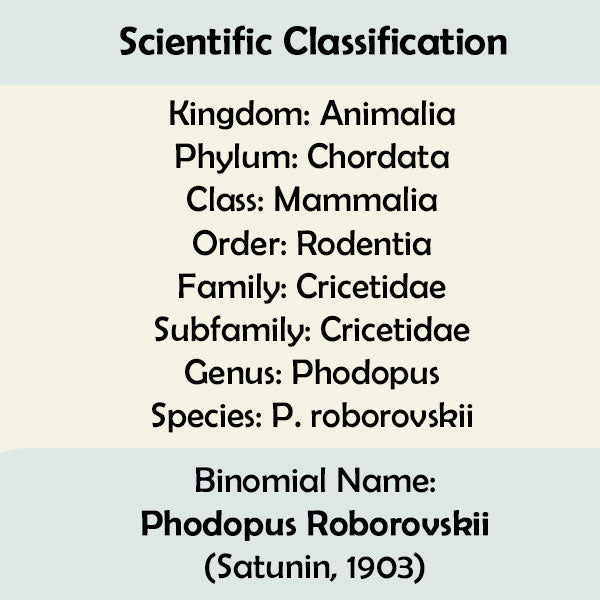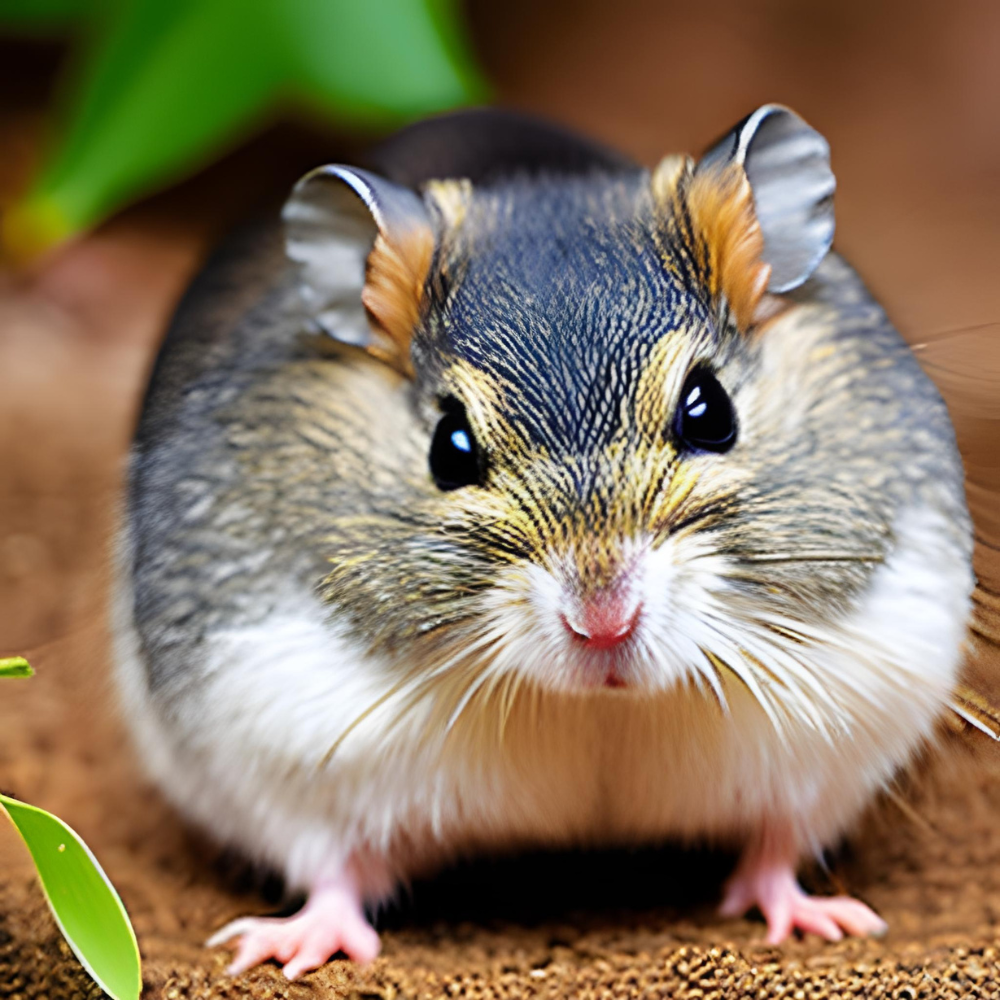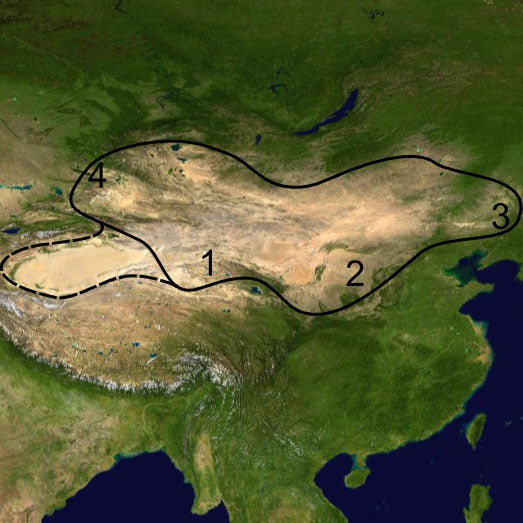Roborovski Dwarf Hamster Care
Often affectionately called 'Robos' or 'Robs' for short, Roborovski Dwarfs are the smallest and fastest of all the hamster species! Adorable, very tiny balls of energy, Roborovski hamsters are captivating to watch as they investigate and enjoy any interactive toys placed in their enclosures.

Phodopus roborovskii - Scientific Classification

Normal Agouti Colouration

Phodopus roborovskii - Distribution Map
Species Information
Formerly classified as Cricetulus bedfordiae, Roborovski Dwarf Hamsters now have a conservation status as a species of Least Concern and have a binomial species name of Phodopus roborovskii. Originally from the deserts of Central Asia including Mongolia, China and Northern Russia, Roborovski Hamsters gained their title from their discoverer (Lt. Roborovski) who first made note of the curious creatures in their deep burrows within semi-arid areas of sparse vegetation over a century ago in 1894. The ancestry of Roborovski Hamsters currently available as pets in the UK can mostly be traced back to a group imported from Holland around 1990.
The colour variation most commonly found in the UK is known as the 'normal agouti', which is also the wild colouration. The distinctive white 'eyebrows', underside and nose allow the Roborovski Hamster to be easily identified among the other dwarf hamster species. The rest of the body is a natural greyish-tan colour with a black undercoat, although as a Roborovski Hamster gets older these black roots can become more evident through the lighter coloured coat. Another mutation, the 'Husky' or 'White Faced' Roborovski, is rarely seen, and causes the hamster to have white facial colouration alongside an almost completely white body.
Living in burrows with steep tunnels of up to 6 foot beneath the sand, wild Roboroviski Hamsters are particularly active in September, October and November. With extreme efficiency when economising their need for water, Roborovski Hamsters require less liquid for hydration than any of the other dwarf hamsters and are able to highly concentrate their urine and survive on very small amounts of water. They are also much less sensitive to extremes of cold temperature than other species in the Phodopus genus. As an omnivorous species, the primarily eat plants and grans but will also eat meat and insects in small quantities when in their wild habitat.
Measuring just 4.5cm to 5cm when fully grown, Roborovski Hamsters are the smallest of the dwarf species usually weighing in at less than 28 grams. Proportionally to their body size, Roborovski Hamsters tend to have longer legs than their close relatives - the Chinese Hamster, the Winter White Russian Dwarf Hamster and the Campbell's Russian Dwarf Hamster. The Roborovski Hamster has 4 toes on each of its front feet and 5 toes on each of its hind paws. The lifespan tends to be between 2 and 3 years, although some have been known to live in excess of 3 years and up to 4 years of age.
Temperament
Roborovski Hamsters are considered a social species and tend to enjoy the company of a same-sex sibling or two, happily living as a duo or a trio provided they have grown up with the others as cage mates. Vigilance is required if owners choose to keep Roborovski Hamsters in larger colonies as this drastically increases the chance of fights breaking out. It is not advised to introduce new hamsters over the age of 3 months or those who have already lived on their own for more than a couple of days. Mixed sex pairs or groups will reproduce quickly and should not be bred by the average pet owner as babies can be difficult to find suitable homes for.
As nocturnal animals, Roborovski Hamsters usually wake up around dusk and are active throughout the night. When handled very regularly during times that they would normally be sleeping, they can begin to adjust to your schedule and spend more time awake during daylight hours. They can take a very long time to tame unless exceptionally well handled as juveniles, and require a lot of attention and patience to get over their skittish nature. A frightened Roborovski Hamster is more likely to bite and clamp onto your skin when frightened than a larger, usually calmer Syrian Hamster.
Due to their miniature size and exceptional speed, Roborovski Hamsters do not tend to be good pets for children unless handling sessions are very heavily supervised. They are not a beginner pet or for novice or nervous handlers as, if they are scared during handling, they are likely to jump from the hands and can be very badly injured by falls. They may never enjoy handling so are ideal for owners who don't expect a pet which will like to be cuddled and held beyond what is necessary for regular health checks, cage maintenance and for moving the hamster to a larger exercise pen.
General Care
The tiny size of the Roborovski Hamster can be misleading in regards to their housing needs, as they are highly active and require plenty of space to race around and create burrows comfortably. Their small bodies allow them to escape through the tiniest of spaces so if housing Roborovski Hamsters in a cage with wire bars, the bars should be too close together for them to wriggle through. Suitable substrates include Chipsi Woodshavings, Aspen bedding and Shredded Paper bedding which should be at least 1.5" deep to allow the hamster to dig and create burrows. Wooden vivariums or glass tanks can also provide suitable habitats for Roborovski Hamsters, allowing them to dig without the substrate being kicked from the cage.
As omnivourous animals, Roborovski Hamsters in the wild appreciate a varied diet of seeds, insects and plant matter. When kept as pets, this can be replaced with a high quality complete hamster food, a small amount of seed such as millet or sunflower hearts and a very small amount of fresh vegetables including carrot, broccoli, cauliflower and cucumber. The extremely efficient kidneys of the Roborovski Hamster mean that they are not accustomed to taking in large amounts of water, so offering too many fresh vegetables at once can cause diarrhoea. Fresh and clean water should be available at all times, via an accessible water bottle or a bowl which is raised from the substrate.
In a single night of foraging for food in the wild, Roborovski Hamsters can cover up to 100 miles. A suitable exercise area is important to allow your hamster to explore a different environment to their normal housing, and an empty bathtub or small pet exercise pen can be used to provide this. Use of a hamster ball allows a Roborovski Hamster to run around your home without danger, provided there are no stairs or predatorial animals in the house. A suitably sized hamster wheel is a necessity to allow natural activity levels in the housing provided, and one with a solid surface should be chosen over a wheel with rungs which may allow feet to be caught.
Care should be taken to recreate a 'wild' habitat for Roborovski Hamsters in captivity as much as is possible. This includes providing deep substrate for digging, which can cover the entire base of their enclosure or can be placed in a Digging Tower. Treats can also be scattered throughout the digging substrate to allow for natural foraging behaviours. Provide Chinchilla sand in a deep but accessible dish or in a Sand Bath for natural rolling and bathing, which helps to maintain the natural oils throughout the coat and promotes healthy skin. Tunnels and Climbing Bridge toys allow Roborovski Hamsters to exercise at different levels as they would in the wild.
Health & Hygiene
The enclosure should be thoroughly cleaned, with all bedding removed and replaced, and disinfected with a pet safe disinfectant at least once per week. Hamsters naturally avoid toileting in their feeding and resting areas, so some areas will become soiled more quickly than others. These soiled spots can be removed daily if required, however a very strong smell with such regular cleaning may indicate that enough bedding is not being used in the habitat. Clean all accessories including tunnels with disinfectant or hot water as appropriate for the material. Contain your hamster in a suitable small pet Transport Box for their safety. Ensure that all components of the enclosure are dry before placing the hamster back in the cage.
Typically, Roborovski Hamsters are very healthy little animals when well looked after. A healthy hamster will be active, alert and sociable, and will eat and drink regularly. They will have healthy fur and clear eyes with no discharge. They will walk normally and the breathing will be unlaboured. Symptoms such as weight loss, abnormal hair loss, distress when breathing, skin lesions, lethargy, nasal or eye discharge or diarrhea indicate serious health issues and require immediate veterinary attention. As a prey animal, Roborovski Hamsters will tend to only show symptoms when disease is severe, so regular health checks are essential.
Hamsters' upper incisors grow throughout their lives so the provision of a constant supply of suitable wooden toys to chew on will help to maintain the teeth at an ideal length. Overgrown teeth will prevent your hamster from eating properly and require veterinary attention for regular trimming if caused by malocclusion. It is normal for the teeth of Roborovski Hamsters to be yellow in colour. Unless dealing with a very elderly or infirm hamster, grooming is unlikely to be necessary as young and healthy hamsters tend to be excellent at maintaining their own cleanliness. The opportunity to bathe in a sand bath regularly will be appreciated by hygiene conscious hamsters.
Is A Roborovski Hamster The Right Pet For You?
For an owner who wants a pet that requires minimal interaction and attention aside from the necessary health checks, dietary requirements and habitat maintenance, Roborovski Hamsters can be the perfect pet! The right owner for a Roborovski Hamster will be patient enough to let the hamster feel relaxed in their company, yet confident enough to handle the hamster efficiently and safely. Robos are incredibly fun to watch as they scuttle about their enclosures, interacting almost immediately to new objects with little hesitation and thoroughly investigating all that is within reach. As with any animal, a potential owner should not take on a Roborovski Hamster unless they are confident they will be able to provide for their new pet (financially and physically) for at least their natural lifespan.


